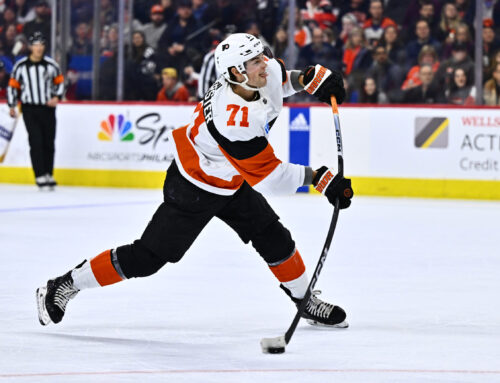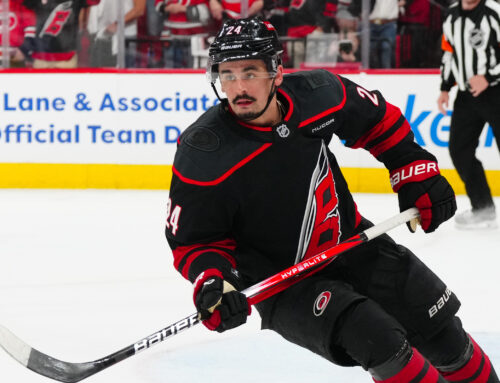
Which under-the-radar forwards from the Eastern Conference should you be monitoring right now?
It is often said that fantasy leagues can be decided by which team finds the late-round gems. In the earlier rounds the correct pick is more obvious and even if you select the wrong player, you still end up in a good spot. However, later in the draft the talent pool is much thinner with many picks destined to become duds and eventually dropped. The task becomes even more difficult in deeper leagues.
Nonetheless, within that talent pool there are a few that will exceed expectations and make a splash in the fantasy world. And if you fail to uncover one of these diamonds in the rough, all is not lost. You can still hit the waiver wire in the early portion of the season and nab an unexpected hot-starter. Regardless of your method, getting higher-level contributions from your depth positions instead of marginal, replaceable production can be enough to put your team over the top.
Today we will examine six forwards and four defensemen that are in positions to contribute but may be flying under the radar in your league due to their secondary roles in the NHL or lack of name recognition. The focus will be put on deeper leagues where the waiver wire will provide limited options and will feature offense-heavy players as well as multi-category specialists.
Note: For more information on each player, click on his name to be taken to his Frozen Pool player profile page.
Forwards
Honorable mention: Derek MacKenzie (FLA) for his great all-around contributions especially in hits and faceoffs and Vladislav Namestnikov (TB) for his strong offensive production in limited minutes.
Ryan Spooner (BOS)
Spooner has been very productive so far despite seeing just third-line minutes while primarily centering summer acquisitions Matt Beleskey and Jimmy Hayes. The Bruins’ hot power play has certainly helped as four of his 10 points have come with the man advantage and he is lining up on the top unit. His PDO and five-on-five on-ice shooting percentage are both normal while his personal shooting percentage is quite high at 16 percent. He does not shoot enough (25 shots in 16 games) to maintain his current scoring pace. This, along with the expected eventual cool-down of the team’s power play efficiency makes Spooner a candidate to slow down in the coming weeks. With that said, do not be surprised if he clears the 40-point mark by the end of the regular season, especially if he can keep his spot on the top power play line.
Teemu Pulkkinen (DET)
Pulkkinen’s strong production which includes five goals in 16 contests is fueled primarily by his 33 shots on goal despite seeing fewer than 13 minutes on the ice per night. Despite the limited utilization, he is still lining up on scoring lines next to the likes of Tomas Tatar, Dylan Larkin and Gustav Nyquist among others while getting secondary power play opportunities. His 60-percent deployment in the offensive zone shows he is being sheltered and put in a position to focus heavily on producing points. Looking ahead, the fact he has logged less than 10 minutes in three of the last six games is concerning. If he can stay in the mix as a reliable depth scorer his stat line could fall in the 40-point range, although more goal-heavy.
Torrey Mitchell (MTL)
Mitchell has been outstanding this year in a fourth-line role and actually finds himself among the league’s elite in some multi-category formats. His line has produced a lot of scoring chances and as a result Mitchell is averaging one point every two games. His early-season surge has come back down to earth with just one point in his last five outings which has put his PDO and five-on-five on-ice shooting percentage back in a normal range. One red flag is his personal shooting percentage which still sits at 23.8 percent. Look for this to drop considerably and continue cutting into Mitchell’s offensive production. His combination of secondary scoring, shots, hits, blocks and six faceoff wins per game make him very coveted in deep multi-category leagues.
J.T. Miller (NYR)
Miller provides a nice combination of depth scoring, shots, hits and blocks which makes him a nice addition to the bottom of a deep-league roster. This year’s nine points in 18 games would indicate he could be taking the next step as an offensive player. Unfortunately, his PDO and five-on-five on-ice shooting percentage are both very high which would indicate his offensive output is due to slow down. His personal shooting percentage is normal so his assists are most likely to take a hit. Until he starts seeing more time on the power play and more minutes overall, Miller’s offensive potential will be limited which makes him more of a valuable commodity in multi-category leagues.
Chris Neil (OTT)
Neil has been a valuable multi-category contributor for most of his career. While he has slowed down offensively, players of his ilk are more of a rarity these days. His penalty minute and hit contributions are elite and he also chips in with some points. His shooting percentage is a bit low at 5.9 percent but his overall offensive potential is severely limited by his average ice time of just eight minutes. His lack of offense might make his stat line look unappealing but his PIM contributions are too valuable to pass up in deep leagues.
Jean-Gabriel Pageau (OTT)
Pageau has quickly become a valuable multi-category contributor despite mediocre point totals. This is primarily due to his high volume of shots, hits, blocks and faceoff wins but his four shorthanded goals in over the last two years (68 total games) cannot be ignored. Looking at this year’s offensive numbers, Pageau’s five points in 18 games is disappointing but his five-on-five on-ice shooting percentage sits at just 3.6 percent, indicating the 23-year-old has been snake-bitten to an extent. Look for the center to get back on track and get a few more assists on the board in the coming weeks.
Defensemen
Honorable mentions: Nathan Beaulieu (MTL) for providing a surprising amount of peripheral contributions to make up for his lack of offense and Marc Staal (NYR) for quietly being a solid peripheral contributor with an outside chance of hitting 30 points this year.
Kevan Miller (BOS)
Miller has flown under the radar due to his perception as an injury-prone depth defenseman. However, the changes made to the Bruins’ blueline and the early-season injuries to Zdeno Chara and Dennis Seidenberg have allowed Miller to emerge in a greater role, logging a career-high 20:27 this year. This has allowed him to increase his hits and blocks per game from last year and even contribute some points. Miller will never be confused with a power-play quarterback but if he can achieve 20 points it would be a nice supplement to what he brings from a physical standpoint. Of course, the injuries remain a concern so always keep an eye on the waiver wire so you can act fast if he goes down with another ailment.
Damon Severson (NJ)
Severson holds value as a prospect due to his offensive upside but sometimes the transition from potential to reality can be a painful process. After a good showing as a rookie last year, his average ice time is actually down from 21:58 to 17:58 this year. His 76-percent offensive zone starts and three minutes per game on the man advantage are an indication that Severson is being sheltered in a role geared for him to produce points. He has responded well with seven points through 16 games but has yet to score a goal on 23 shots. It is only a matter of time before he puts a few goals on the board and in the end should finish somewhere between 30 and 40 points.
Calvin de Haan (NYI)
In multi-category leagues that count blocked shots it is important to add a couple defensemen that are heavy shot-blockers. The NHL’s second-leading blocker is de Haan who has 53 in 18 contests. Additionally, he shoots a lot for a defenseman, gets over two hits per game and is even a decent PIM contributor. The downfall is his limited offensive contributions mainly due to his lack of power play time. While unlikely to happen on the current Islanders’ squad, de Haan showed back in 2013-14 what he is capable of offensively when given a role on the power play as he produced at a 26-point pace that year. Just keep in mind there is potential for a solid uptick in production if the team gets hit by a rash of injuries.
Radko Gudas (PHI)
When it comes to getting hits, blocks and PIM from your blueline, few are better than Gudas. He started the year getting fewer minutes after coming back from a major knee injury but he has logged 19 or more minutes in nine of his last 11 games and his peripheral stats have been significant. In addition to his physical play, Gudas is also normally decent offensively although it has not shown yet this year. His five-on-five on-ice shooting percentage of just 5.7 percent indicates he has been unlucky while on the ice and is due for a few extra points. His PIM have also not been up to his standards but we have to be patient here. PIM are often picked up in bunches and Gudas has not yet picked up any major penalties.
*
Follow me on Twitter @DH_EricDaoust and be sure to check out Frozen Pool as features continue to be improved every week. Here is some insight on what you will find in the best fantasy hockey player profile on the web. Recently a calculator displaying statistics for games within a custom date range has been added to goalie profile pages.





 CHI
CHI MTL
MTL N.J
N.J CBJ
CBJ BOS
BOS PIT
PIT DET
DET ANA
ANA L.A
L.A COL
COL
